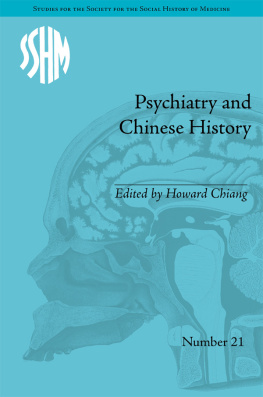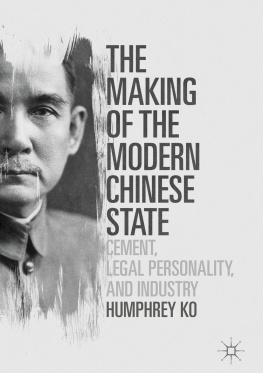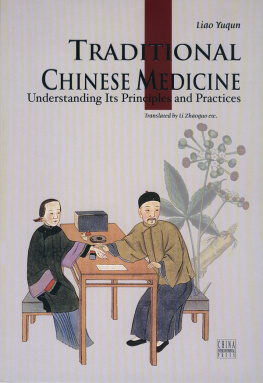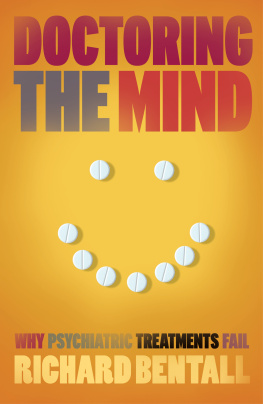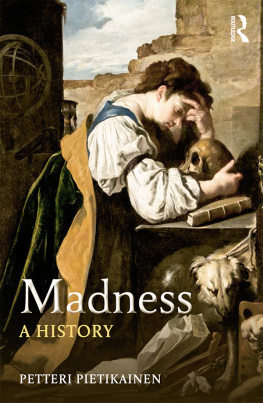Chiang - Psychiatry and Chinese history
Here you can read online Chiang - Psychiatry and Chinese history full text of the book (entire story) in english for free. Download pdf and epub, get meaning, cover and reviews about this ebook. City: China, year: 2014, publisher: Routledge;Pickering & Chatto, genre: Religion. Description of the work, (preface) as well as reviews are available. Best literature library LitArk.com created for fans of good reading and offers a wide selection of genres:
Romance novel
Science fiction
Adventure
Detective
Science
History
Home and family
Prose
Art
Politics
Computer
Non-fiction
Religion
Business
Children
Humor
Choose a favorite category and find really read worthwhile books. Enjoy immersion in the world of imagination, feel the emotions of the characters or learn something new for yourself, make an fascinating discovery.
Psychiatry and Chinese history: summary, description and annotation
We offer to read an annotation, description, summary or preface (depends on what the author of the book "Psychiatry and Chinese history" wrote himself). If you haven't found the necessary information about the book — write in the comments, we will try to find it.
Chiang: author's other books
Who wrote Psychiatry and Chinese history? Find out the surname, the name of the author of the book and a list of all author's works by series.
Psychiatry and Chinese history — read online for free the complete book (whole text) full work
Below is the text of the book, divided by pages. System saving the place of the last page read, allows you to conveniently read the book "Psychiatry and Chinese history" online for free, without having to search again every time where you left off. Put a bookmark, and you can go to the page where you finished reading at any time.
Font size:
Interval:
Bookmark:
Brigid E. Vance
In the twentieth century, dreams were demystified by focusing on the measurable neurobiological impact of dreaming, especially on memory processing and consolidation. Scientific studies attest to the role of REM sleep (when dreaming occurs) in memory processing and consolidation, particularly in emotionally charged memories. Behavioural studies of sleep and learning in both animals and humans attest to the neurobiological and neurophysiological basis of sleep-dependent memory processing. Chronic nightmare sufferers, sleepwalkers and narcoleptics today can turn to medical professionals for treatment such as nightmare imagery rehearsal therapy, diet changes, stimulants, anti-depressants, and more. But, how were dreams and nightmares treated in other historical times and places? How were dreams and nightmares defined and differentiated from one another? How were dreams and nightmares dealt with in late Ming China (13681644)?
Below, these questions will be addressed, viewed through the lens of meng rang [Dream Exorcism], one of four sections in the 1636 compendium Meng lin xuan jie [An Explication of the Profundities in the Forest of Dreams; hereafter Forest of Dreams]. In addition to cataloguing and organizing nearly 5,000 dream examples from the dynastic histories, Forest of Dreams also provided readers with practical solutions for self-healing. Dream Exorcism presented twenty-five images of talismans, accompanying incantations and advice aimed either generally at ensuring a good night's sleep, or specifically at offering protection against the deleterious effects of inauspicious dreams or nightmares.
This chapter argues that Dream Exorcism was a repository of dream-related knowledge, aimed at organizing and categorizing dreams for dream prognostication practitioners and readers alike. Dream Exorcism set the parameters for what could and should be done with dreams and provided the vocabulary and tools to educate readers on how to view and treat dreams and nightmares; moreover, it disciplined readers, not only offering them a means to comprehend the world of dreams, but also the methods necessary to escape a world of nightmares. It can be read as much as a how-to medical text on dreams as a compilation of knowledge or general dream lore. This chapter explores two inter-related themes: the publicization of specific dream-related medical knowledge and the medicalization of dreams and nightmares. Here, the parameters of the term medicalize encompass the somatic, psychological, moral and spiritual. As is apparent from the sleep-related advice and treatment techniques in Dream Exorcism, dreams were a barometer of health and well-being. Nightmare sufferers in the seventeenth-century Chinese context relied upon specific material, conceptual and spiritual means to heal themselves.
This reading of Dream Exorcism underscores both the apparent physical and moralistic impacts of dreams and nightmares. Dream Exorcism instructed nightmare sufferers to look inward and outward; inward to a corporeal realm populated with benevolent and innocuous spirits along with malevolent demons, and outward to a pantheon of spirits and gods who communicate with individuals through dreams. Individuals dreams apparently connected these two realms. Nightmares were thus considered both a product of both internal and external factors. The preface and the contents of Dream Exorcism reveal a moralistic overtone not simply to nightmare treatment and prevention, but to dreams and dreaming as well. Nightmare sufferers were conceived of as being at least partially responsible for bringing these nightly terrors upon themselves.
What were dreams and nightmares? Dreams purveyed messages from spirits, and thus offered the potential means to self-understanding or religious revelations. Contemporary and earlier texts strongly indicated that even positive or auspicious dreams were not desirable and that true sages and enlightened persons did not dream. Thus, the mental state of non-dreamers was perhaps deemed more settled or less disturbed. Nightmares indicated either a physical or spiritual imbalance or possession by demons. Texts were devoted to explaining ways of attracting auspicious dreams and repelling negative ones. Spells used against nightmares date from as early as the third century BC.
Forest of Dreams
Firstly, it is necessary to introduce the source, its compilers, and its audience. Forest of Dreams consists of thirty-four volumes and is 1,278 pages long. It is the largest extant dream compendium from the Ming dynasty (13681644). In addition to indexing and cataloguing nearly 5,000 dream interpretation examples, this tome also provided readers with practical solutions for self-healing. Forest of Dreams incorporated a broad spectrum of texts, genres and literary modes drawn from multiple sources. The compilers of Forest of Dreams chose which sources to include, then edited and organized the contents. The work represents a layering of multiple textual translations, taken from historical works and organized thematically.
An examination of this thirty-four-volume work highlights the complex ways in which dreams were used. To the compilers of Forest of Dreams, dreams offered the means to justify career and life choices, understand the present and predict the future, and gauge health. Dreams were credited as an integral and often determining factor in the quotidian choices made by the literati compilers. In other words, dreams were tied up as part of a belief system; dreams were inextricably linked to fate and inevitability, health and illness, and reflections of a certain anxious state of mind or a certain as yet uncovered truth. An examination might be failed and the promise of a glorious official career lost. An illness might worsen, leading to death. Life was uncertain and dreams were a means to address this uncertainty and alleviate the associated worry.
According to its prefaces and table of contents, Forest of Dreams comprises five previously published and subsequently revised dream encyclopaedias, two of which are extant. Chen Shiyuan's (151695) Meng zhan yi zhi [Guidelines to Dreams and Dream Interpretation], first published in 1564, and Zhang Fengyi's (15271613) Meng zhan lei kao [Classified Studies of Dream Interpretations], first published in 1585, are both quoted in Forest of Dreams, minus the commentary. The remaining titles date from the Tang and Song dynasties and do not exist separately from Forest of Dreams. In the title page and four general prefaces, primary compiler He Dongru (15721637) presented Forest of Dreams as the partial recovery of a heretofore secret dream prognostication manual, purportedly written by a Daoist sage in the third century, and re-discovered in the early seventeenth century, supposedly in He Dongru's family library.
The title page of Forest of Dreams asserted that the work represented the partial retrieval of knowledge on dreams and dream interpretation, crediting Daoist master Ge Hong (AD 284364) as the author of portions of the text. Because He Dongru attributed partial authorial credit to Ge Hong, a claim which cannot be verified, Forest of Dreams was later dismissed as a partial forgery by the Qing editors of the Siku quanshu [Four Treasuries Imperial Library]. Ge Hong was a well-known Daoist, who wrote Bao pu zi [(Book of the) Master who Embraces Simplicity], which includes talismans and techniques for immortality elixirs. Due to his upright qualities and compassion for the poor and sick, Ge Hong was bestowed with the title Daoist Heavenly Master (Tian shi zhi zhi ) and honored as a deity. It is arguable that Forest of Dreams used Ge Hong's name to lend both authority and credibility to the late Ming compendium. The compilers promoted themselves and their editorial efforts as tied to a lineage of famous dream interpreters, beginning with Ge Hong.
Font size:
Interval:
Bookmark:
Similar books «Psychiatry and Chinese history»
Look at similar books to Psychiatry and Chinese history. We have selected literature similar in name and meaning in the hope of providing readers with more options to find new, interesting, not yet read works.
Discussion, reviews of the book Psychiatry and Chinese history and just readers' own opinions. Leave your comments, write what you think about the work, its meaning or the main characters. Specify what exactly you liked and what you didn't like, and why you think so.

